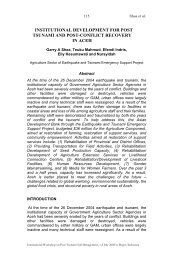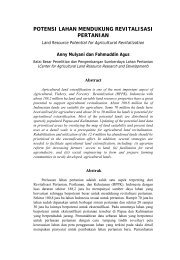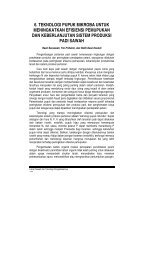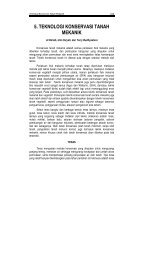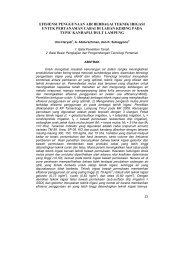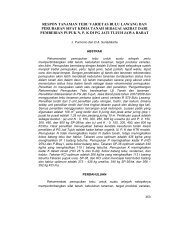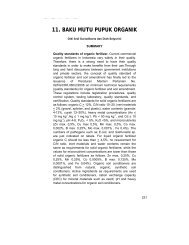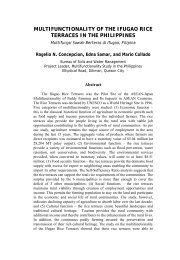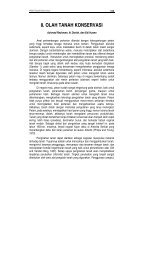Proceedings - Balai Penelitian Tanah
Proceedings - Balai Penelitian Tanah
Proceedings - Balai Penelitian Tanah
You also want an ePaper? Increase the reach of your titles
YUMPU automatically turns print PDFs into web optimized ePapers that Google loves.
99<br />
Sembiring et al.<br />
level of tolerance to all the stresses that occur in its growing<br />
environment. Thus, in breeding rice for saline environments, multiple<br />
stress tolerance traits must be considered. Further more, Zeng and<br />
Shannon (2000) reported that rice is rated as an especially saltsensitive<br />
crop. The response of rice to salinity varies with growth<br />
stage. In the most commonly cultivated rice cultivars, young seedlings<br />
were very sensitive to salinity. Yield components related to final grain<br />
yield were also severely affected by salinity; panicle length, spikelet<br />
number per panicle, and grain yield were significantly reduced. Salinity<br />
also delayed the emergence of panicle and flowering and decreased<br />
seed set through reduced pollen viability.<br />
The 2004 tsunami caused significant degradation to agricultural lands<br />
in the coastal region of NAD. The most affected was lowland rice. The<br />
rice crop productivity is constrained by a combination of poor seed<br />
quality, use of unsuitable varieties, sub-optimal soil fertility and climate<br />
variability. To reduce these constraints in tsunami-affected areas of<br />
the east and west coast of NAD, the ACIAR tsunami recovery projects<br />
in NAD i.e. SMCN 2005/118 and CP2004/05 followed by<br />
LWR/2005/118 was aimed at restoring livelihoods through the reestablishment<br />
of annual cropping – especially rice cropping, and to<br />
reduce the reliance on food aid in tsunami-affected areas of NAD.<br />
Several activities have been completed for this project and some<br />
results have been implemented with farmers in NAD. Capacity<br />
building through workshops and training, research and variety trials –<br />
especially on rice cropping - demonstrating of crop management<br />
packages have been completed and evaluated.<br />
Through this article, the information on salinity affected soil and rice<br />
crop, especially in NAD after tsunami, is described and the most<br />
feasible remedial measure is suggested. Last, but not least, the<br />
implications of salinity research for Indonesian rice growing is also<br />
discussed.<br />
TSUNAMI IN NANGGROE ACEH DARUSSALAM<br />
Tsunami on December 26, 2004 destroyed agricultural land along the<br />
western and eastern coast of NAD. The Agriculture Department of<br />
Ministry of Agriculture, the Government of Republic of Indonesia has<br />
assessed the area affected on food crops by tsunami in east and west<br />
coastal districts of Nanggroe Aceh Darussalam (NAD) (Table 1).<br />
At Aceh Besar district 11% of rice crop area was destroyed, especially<br />
at Ingin Jaya, Pekan Bada, Lhoknga and Syah Kuala sub-districts. At<br />
Pidie district 10.5% of rice crop areas were destroyed, especially at<br />
Pidie city and Indra Jaya sub-district. Further more; at Bireuen and<br />
Aceh Barat districts 8.1% and 14.7% rice land were devastated by<br />
International Workshop on Post Tsunami Soil Management, 1-2 July 2008 in Bogor, Indonesia



